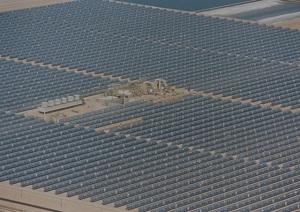California unions at odds over large-scale solar development
 Last month, CURE, the California Unions for Reliable Energy, sued the Bureau of Land Management over its approval of the NextEra Energy Inc.’s (Nasdaq: NEE) 250-megawatt Genesis Solar Energy Project. The organization cited concerns about the amount of water the project used. But other California unions criticized the action and said it was the latest example of CURE’s strong-arm tactics to negotiate lucrative contracts for the union.
Last month, CURE, the California Unions for Reliable Energy, sued the Bureau of Land Management over its approval of the NextEra Energy Inc.’s (Nasdaq: NEE) 250-megawatt Genesis Solar Energy Project. The organization cited concerns about the amount of water the project used. But other California unions criticized the action and said it was the latest example of CURE’s strong-arm tactics to negotiate lucrative contracts for the union.
Jose Mejia, director of the California State Council of Laborers and Daniel Curtin, director of the California Council of Carpenters, are up in arms over CURE’s actions.
They accuse CURE of using legal actions to slow progress on important projects that not only complicate the process, but also could cost Californians' jobs, resulting in developers of large-scale solar projects leaving for other states.
They also observed that as soon as CURE secures contracts with the project developer, they have dropped lawsuits or stopped objecting to the project in question.
According to an article recently published by the L.A. Times, when CURE contracts are secured, they include an industry promotion fund contribution. Some of which add up to $400,000. The fund is allegedly used to pay lawyers and staff for future legal actions.
“We believe they use environmental quality laws to extort [contracts],” Curtin said. “We’re for organizing, but not for abusing the industry, taking the industry hostage or the environment hostage.”
Mark Joseph, of environmental law firm Adams Broadwell Joseph & Cardozo, who represents CURE doesn’t see it that way.
“The allegation that CURE drops environmental issues is false. And we are very disappointed because we showed the evidence to the L.A. Times reporter, and he ignored it,” he said. “More importantly, the question we have is: What information are we bringing to the attention to the agency that the developer would prefer remain hidden?”
CURE sued BLM in late December 2010, alleging that the approval should not have been granted given the Genesis project’s use of water from an aquifer connected to the Colorado River without an entitlement.
“Everyone believes the case is meritless,” Curtin said.
He said CURE’s concern over the environmental implications of the project is disingenuous. Curtain said that while CURE issued the lawsuit against the Genesis project on one side of the Colorado River, the group hasn’t objected to a project on the other side of the river where it already has a contract.
“It’s pretty blatant. They’ve gotten arrogant about it,” he said.
Mejia said he is worried about local jobs.
“I’m not sure that using environmental objections is in the best interest of our people,” he said. “It’s holding up this process. Specifically, right now, it’s making things worse. This is costing jobs here.”
But Joseph threw doubt onto the veracity of the other unions’ allegations.
“The carpenters union is just a mouthpiece for the developer,” he said. “They're just being used as pawns by the developer.”
Asked whether CURE would drop the lawsuit against BLM if CURE’s parent, California’s State Building and Construction Trades Council, secured labor contracts with NextEra, Joseph responded, “We would not drop the lawsuit. The allegation in the article is a lie.”
NextEra Energy did not respond to a request for comment by press time.
Pictured: NextEra's SEGS VIII 80 MW solar thermal plant, courtesy of Sandia National Laboratories.



